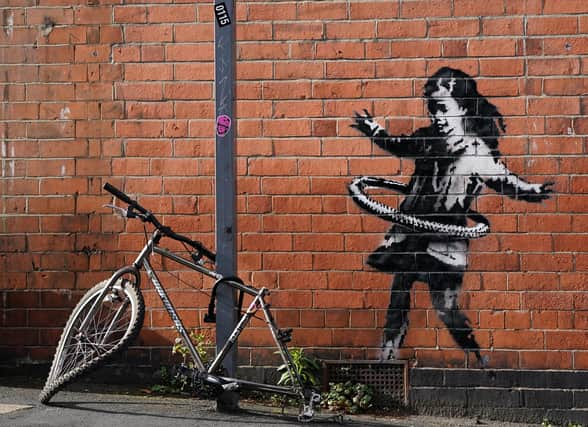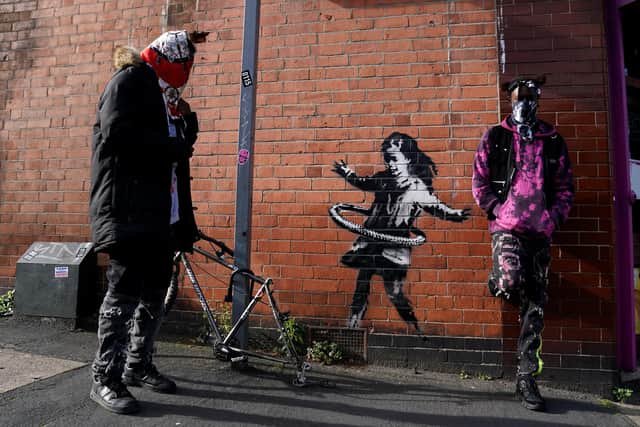Banksy: Nottingham artwork of hula hooping girl has been removed – what happened to the art?


The most recent artwork of elusive street artist Banksy has been bought and removed from a wall in Nottingham.
The mural - depicting a young girl hula hooping with a rear bike tire next to a real life bicycle, chained to a lampost and missing its rear wheel - appeared on the corner of Rothesay Avenue outside a beauty salon in October 2020.
Advertisement
Hide AdBefore Banksy could confirm whether or not the piece is indeed one of his works, a protective screen was put in place to protect the potentially valuable art, but now the work and the wall it rests on has been removed.


Here is everything you need to know.
What has happened to the mural?
The artwork has been purchases by John Brandler, owner of Brandler Galleries in Brentwood, Essex, who spent “a six-figure sum” to buy the mural.
The art collector has said he has saved it from a “death sentence” despite protests from locals, as the artwork had started to form mould within its protective plastic casing.
Brandler said he is paying thousands of pounds to send the artwork to Scotland where it will be restored, before being relocated to a museum in Suffolk.
“If I hadn’t bought it and removed it, in two years’ time there wouldn’t have been a Banksy there at all,” he told the PA news agency. “I appreciate the council were trying to protect it from vandals coming along but actually it was creating a death sentence for it."
The Banksy is one of several Brandler has purchased, including Season’s Greetings in Port Talbot, Wales. The artwork will eventually be displayed in a museum in Bury St Edmunds, but Brandler said the entire exhibition could return to Nottingham in the future.
Advertisement
Hide AdAsked if he had a message for residents upset by the removal of the artwork, Brandler said: “Somebody told me it belongs to the people of Nottingham – no, it belonged to the person whose wall it was on.
“From what I hear they offered it to a number of organisations in Nottingham and nobody was interested."
What does the mural mean?
Advertisement
Hide AdAt the time of its appearance, Nottingham was experiencing some of the highest rates of coronavirus infections, with fears the Government was to bump up the city to its Tier 3 restrictions.
Many speculated this was the reason Banksy chose the city as the location for his piece.
"Nottingham needs something like this right now - something to talk about rather than coronavirus," resident Josinya Powell told the BBC. "If it is Banksy that'd be amazing - I'd say to him, ‘Thanks babes'."
Others suggested the bike in the mural was symbolic of the city’s Raleigh factory. The famous bike manufacturer - one of the oldest bicycle companies in the world - closed its Nottingham factory in 2002, ending 114 years of bicycle production in the city and sparking the loss of nearly 300 jobs.
At the time, Raleigh said cheap imports from the Far East were largely to blame for the decision.
How was the mural painted?
The creation of the artwork was carried out in relatively little secrecy, reportedly in broad daylight.
Advertisement
Hide AdNearby shop owner, Alex Mitchell, described seeing the artwork unfold when a van "with blacked out windows" pulled up at about 5pm on Tuesday 13 October.
Mitchell told the BBC, "I only saw the driver. I didn't know what was going on or whether I should call the police.”
Advertisement
Hide AdA piece of cardboard was left "gaffer taped to the wall", and when Mitchell returned the next day, the same person was there again.
"He pretended like he had broken down but he was there for at least two hours. I asked him 'Who is the artist?' and he just winked at me. I'm not going to say whether it is Banksy or not. It definitely looks like one, but no one saw who painted it.”
Mr Mitchell said at one point the man came into his shop and bought two bottles of Ribena.
